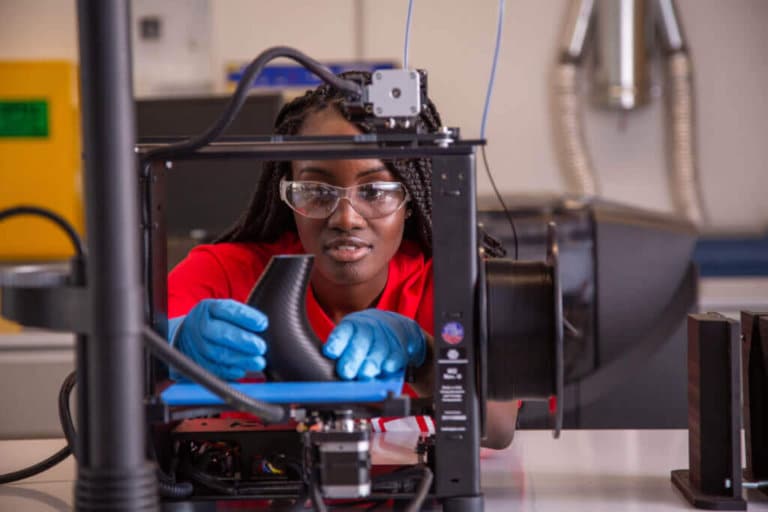
Engineers possess a pivotal role in shaping the world around us, channeling their expertise to design cutting-edge technologies and forge sustainable infrastructures. The diversity of their profession unveils a myriad of job opportunities, rendering engineering a career path that is certainly appealing — and future-proof. Even in our ever-evolving job market, the demand for proficient engineers remains steadfast and enduring.
According to the US Bureau of Labor, a staggering 140,000 new engineering positions will materialise by 2026 in the United States alone. Among the most sought-after disciplines are civil engineering, aerospace engineering, industrial engineering, agricultural engineering, environmental engineering, chemical engineering, and biomedical engineering.
If you’re considering a career in engineering, choosing the right university is vital. Fortunately, the US boasts several esteemed institutions that provide an exceptional foundation to enter this dynamic field. To narrow down your list, here are five worth considering:
Lamar University

LU Engineering students become career-ready thanks to dedicated faculty members and innovative courses. Source: Lamar University
Lamar University’s College of Engineering is home to five departments: chemical engineering, civil and environmental engineering, electrical engineering, industrial and systems engineering, and mechanical engineering. Each does more than offer ABET-accredited undergraduate and graduate degree programmes — they transform students into engineers equipped with the necessary tools to tackle modern challenges anywhere in the world.
“We currently have 46 full-time faculty members, 1,255 undergraduate students, 325 masters’ students and 67 doctoral students,” says Dr. Brian Craig, dean of the College of Engineering. “Lamar University’s College of Engineering is the place for students, faculty, and staff that are driven to make a difference in society.”
According to Payscale.com, Lamar University is the third-best engineering school in the nation for return on investment and second-best for average alumni salaries. Bestvalueschools.com ranks the College of Engineering at Lamar University as the 20th best in the country. Other than its stellar accolades, another benefit of studying here is the many pathway options. “The college remains steadfast in our commitment to our students to provide a state-leading return on the educational investment and to assist them in their employment,” says Craig. “All 15 master’s degree options in the college now offer 4+1 pathways, and we are offering six new certificates that students can take as part of their degree program or as a standalone certificate for nondegree-seeking students.”
Employability is a crucial aspect, and at this college, students can participate in co-op and internship programmes. There are industry seminars, community outreach, career fairs and more as well to help you build a career in engineering. With the right industry connections, you can explore numerous experiences and even land your dream job.
Johns Hopkins University

The first research university in America, Johns Hopkins has built an international reputation on its curriculum. Source: Johns Hopkins University
The Whiting School of Engineering at Johns Hopkins University stands tall as a globally recognised institution renowned for its excellence in engineering education. With over 50 academic programmes on offer, it’s little wonder why its graduates forge successful careers across diverse industries — making the School a true breeding ground for accomplished professionals.
These programmes are delivered from 10 academic departments: The Centre for Leadership Education, the Department of Applied Mathematics and Statistics, Department of Biomedical Engineering, Department of Chemical and Biomolecular Engineering, Department of Civil and Systems Engineering, Department of Computer Science, Department of Electrical and Computer Engineering, Department of Environmental Health and Engineering, Department of Materials Science and Engineering, and the Department of Mechanical Engineering.
Options aside, the Whiting School of Engineering garners acclaim for its unwavering commitment to research excellence. Esteemed faculty members at the school spearhead groundbreaking research ventures in various engineering fields, and every student has the chance to contribute to their efforts. By actively participating in hands-on research, learners not only gain invaluable experience but also leave an indelible mark on the world through their contributions — this can be done within one or several of the School’s 20 established research centres and institutes.
Real-world knowledge can also be gained through internships, co-ops or by joining some of over 18 student organisations. Here, experience matters, hence why undergraduates are expected to apply knowledge early on. In fact, first-semester students are expected to conduct research alongside a faculty member. Global mindsets are important, too, which is why learners are encouraged to spend a semester abroad or take on a short-term service-learning trip during their time at the Whiting School of Engineering.
University of Rochester

The University of Rochester’s ECE department has 22 full-time faculty. Source: University of Rochester
The University of Rochester’s Department of Electrical and Computer Engineering (ECE) has made significant strides over the years, elevating its ranking from 75th to 68th among departments in the US. This achievement can be attributed to the exceptional expertise of its renowned faculty, who are experts in Robotics, Signal Processing, Ultrasound Imaging, Image Processing, Circuits and Computer Systems, Nanoscale Electronics and Photonics, Medical Imaging, and Quantum Engineering.
Recently, several Diagnostic Imaging powerhouses have joined their ranks to offer a dynamic postgraduate programme to learners interested in pursuing careers that revolve around the topic. The Master of Science in Diagnostic Imaging will soon be the first and only programme in the US that sees engineering students learning alongside medical residents. Together, they will relish lessons that aim to align imaging fundamentals from engineering with radiological applications observed in an immersive clinical environment. The programme is set to launch in 2024, offering learners a 50% tuition discount.
Those without any time to waste can take comfort in knowing that the ECE is already home to several other master’s programmes with an eye on the future — like the 30-credit-hour Master of Science in Electrical Engineering. This research-heavy path touches on a range of disciplines, such as computer engineering and architecture, signal processing, communications, medical imaging, digital audio and music, photonics, and nanoscale electronics. Much like the upcoming MS in Diagnostic Imaging, this existing route is a gift that keeps on giving, with 40 to 50% tuition discounts being offered to MS students and 100% tuition discounts available to PhD applicants.
Bowling Green State University

Through BGSU’s robust co-op education, students directly interact with industry settings and develop soft skills that boost their employability. Source: Bowling Green State University
Ingenious solutions abound when keen minds meet top-tier education in the Department of Engineering Technologies (ENGtechs) at Bowling Green State University (BGSU). An engineering degree is notorious for being costly, but this university in Ohio dispels any myth that quality education has to come with a hefty price tag. It was ranked the number one public university students would choose again in the Midwest for the third year in a row by the Wall Street Journal, and ranks third for teaching quality among public universities in the US.
ENGtechs’s core mission is to provide the best quality in engineering and engineering technology education that is current and relevant to industry players. It includes instruction in small classrooms that mix lectures and practical experiences, and mandatory one to three paid co-op placement, which students can leverage when transitioning into full-time employment. The university’s co-op programme is accredited by the Accreditation Council for Co-op and Internship (ACCI).
Ohio’s reputation as America’s manufacturing heartland offers many job opportunities to graduates, making BGSU an ideal destination for aspiring engineers. An impressive 97% of its graduates will either secure a job, progress to graduate school or start their own business within six months of completing their studies. This is thanks to BGSU’s robust co-op education, where students directly interact with industry settings and develop soft skills that boost their employability. As a result, students are work-ready at the onset of their careers and are well-equipped to assume leadership roles in the future.
Western Michigan University

College of Engineering and Applied Sciences students are active in and around Floyd Hall. Daniel Nyambane is seen with a study group. Source: Western Michigan University
Western Michigan University (WMU) College of Engineering and Applied Sciences graduates have an edge as their degrees include hands-on experiences and projects with applications outside of the classroom.
Students have access to the best equipment as well as the chance to solve real problems. Dr. Damon Miller, associate professor of electrical and computer engineering, notes that the senior design courses enable students to put what they learn to the test. “Experiential learning that puts theory into practice is an absolutely critical component of engineering education, since the real world is messy and definitely not compartmentalised,” he says.
“Real‐world projects are rarely well defined. Laboratories associated with a specific course are one component of this experiential learning. The best labs feature open‐ended projects to develop engineering solutions to an identified need and also require defining the problem scope. Many times in my career I have wasted time solving a problem that turned out not to be what I should have been solving in the first place!”
WMU College of Engineering and Applied Sciences students apply their craft to projects on the ground, as well. The university is home to the Centre of Excellence for Structural Durability, established in partnership with the Michigan Department of Transportation (MDOT), to help shape the future of transportation in the state. For example, earlier this year, a team of students, led by professor of civil and construction engineering and the centre’s director Dr. Upul Attanayake, accurately determined the timeline for applying epoxy overlays and protective sealers to new concrete on the surface of Michigan bridges.
*Some of the institutions featured in this article are commercial partners of Study International







